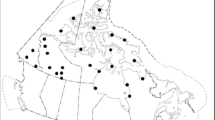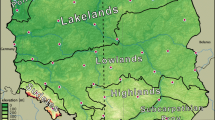Summary
Temperature variability in Winnipeg, Canada, was assessed by determining average and extreme temperature ranges over 1, 2, 5, 10, and 15-day intervals, on a monthly basis, for the period of 1872–1993. Trends in the monthly averages for each of the intervals were also examined.
The results show that Winnipeg experiences a very large amount of short-term temperature variability, especially over 2, 5, 10 and 15 days. The monthly average diurnal ranges vary from about 9 to 14 °C, while the 15-day average ranges are about two to three times as large. In general, average temperature ranges over the two shortest intervals (1 and 2 days) are slightly greater in the warm-season months than in the cold-season months, but the averages for the three longest intervals are inversely related to mean monthly temperature, as are the largest ranges observed in each of the months.
Average temperature variability in the months of November through March was found to have decreased quite significantly, and rapidly, during the first two decades of this century. This decrease was likely associated with a decrease in the meridionality of the atmospheric circulation. It also occurred during a time when the average maximum and minimum temperatures in Winnipeg were rising, lending support to the conjecture that a warmer global climate will result in less 1–15 day temperature variability. The rapidity of the change also supports the hypothesis that climate changes tend to be non-linear.
Similar content being viewed by others
References
Anderson, T. W., Rochard, C., 1979: Cold snaps, snowfall and sudden death from ischemic heart disease.Can. Med. Assoc. J. 121, 1580–1583.
Balling, R., Lawson, M. P., 1982: Twentieth-century changes in winter climatic regions.Climatic Change 4, 57–69.
Blair, D., 1996: The climate of Manitoba. In: Welsted, J., Everitt, J., Stadel, C. (eds.)The Geography of Manitoba: Its Land and Its People. Winnipeg: The University of Manitoba Press, pp. 31–39.
Calef, W., 1950: Interdiurnal variability of temperature extremes in the United States.Bull. Amer. Meteor. Soc. 31 (8), 300–302.
Cao, H. X., Mitchell, J. F. B., Lavery, J. R., 1992: Simulated diurnal range and variability of surface temperature in a global climate model for present and doubled CO2 climates.J. Climate 5, 920–923.
Dickson, R. R., Namias, J., 1976: North American influences on the circulation and climate of the North Atlantic sector.Mon. Wea. Rev. 104, 1255–1265.
Driscoll, D. M., Yee Fong, Y. M., 1992. Continentality: a basic climatic parameter re-examined.Int. J. Climatol. 12, 185–192.
Driscoll, D. M., Rice, P. B., Yee Fong, J. M., 1994: Spatial variation of climatic aspects of temperature: interdiurnal variability and lag.Int. J. Climatol. 14, 1001–1008.
Environment Canada, 1995:The State of Canada's Climate: Monitoring Variability and Change. SOE Report No. 95-1. Ottawa: Environment Canada.
Hansen, J., Sato, M., Ruedy, R., 1995: Long-term changes of the diurnal temperature cycle: implications about mechanisms of global climate change.Atmos. Res. 37, 175–209.
Houghton, J. T., Jenkins, G. J., Ephraums, J. J. (eds.), 1990:Climate Change: The IPCC Scientific Assessment. New York: Cambridge University Press.
Houghton, J. T., Callander, B. A., Varney, S. K. (eds.), 1992:Climate Change. The Supplementary Report to the IPCC Scientific Assessment. New York: Cambridge University Press.
Houghton, J. T., Meiro Filho, L. G., Callander, B. A., Harris, N., Kattenburg, A., Maskell, K. (eds.), 1996:Climate Change 1995: The Science of Climate Change. New York: Cambridge University Press.
Jones, P. D., 1994: Hemispheric surface air temperature variations: a reanalysis and an update to 1993.J. Climate 7, 1794–1802.
Kalkstein, L. S., Davis, R. E., 1989: Weather and human mortality: an evaluation of demographic and interregional responses in the United States.Ann. Ass. Am. Geograph. 79, 44–64.
Kalnicky, R. A., 1974: Climatic change since 1950.Ann. Ass. Am. Geograph. 64, 100–112.
Kalnicky, R. A., 1987: Seasons, singularities, and climatic changes over the midlatitudes of the Northern Hemisphere during 1899–1969.J. Climate Appl. Meteor. 26, 1496–1510.
Karl, T. R., Kukla, G., Gavin, J., 1984: Decreasing diurnal temperature range in the United States and Canada from 1941 through 1980.J. Climate Appl. Meteor. 23, 1489–1504.
Karl, T. R., Riebsame, W. E., 1984: The identification of 10-to 20-year temperature and precipitation fluctuations in the contiguous United States.J. Climate Appl. Meteor. 23, 950–966.
Karl, T. R., Knight, R. W., Plummer, N., 1995: Trends in high-frequency climate variability in the twentieth century.Nature 377, 217–220.
Kukla, G., Gavin, J., Schlesinger, M., Karl, T., 1995: Comparison of observed seasonal temperature maxima, minima and diurnal range in North America with simulations from three global climate models.Atm. Res. 37, 267–275.
Lepage, Y., 1971: A combination of Wilcoxon's and Ansari-Bradley's statistics.Biometrika 58, 213–217.
Lorenz, E. N., 1968: Climate determinism.Met. Mono. 8, 1–3.
Lorenz, E. N., 1976: Non-deterministic theories of climatic change.Quat. Res. 6, 495–506.
Mearns, L. O., Giorgi, F., McDaneil, L., Shields, C., 1995: Analysis of variability and diurnal range of daily temperature in a nested regional climate model: comparison with observations and doubled CO2 results.Clim. Dynamics 11, 193–209.
Mearns, L. O., Rosenzweig, C., Goldberg, R., 1996: The effect of changes in daily and interannual climatic variability on CERES-Wheat: a sensitivity study.Climatic Change 32, 257–292.
Riha, S. J., Wilks, D. S., Simoens, P., 1996: Impact of temperature and precipitation variability on crop model predictions.Climatic Change 32, 293–311.
Rind, D., Goldberg, R., Ruedy, R., 1989: Change in climate variability in the 21st century.Climatic Change 14, 5–37.
Robinson, D. A., Leathers, D. J., Palecki, M. A., Dewey, K. F., 1995: Some observations on climate variability as seen in daily temperature structure.Atmos. Res. 37, 119–131.
Saez, M. J., Sunyer, J., Castellsagué, J., Murillo, C., Anto, J. M., 1995: Relationship between weather, temperature and mortality: a time series analysis approach in Barcelona.Int. J. Epidemiology 24, 576–582.
Semenov, M. A., Porter, J. R., 1995: Climatic variability and the modelling of crop yields.Agric. Forest Meteor. 73, 265–283.
Skeeter, B. R., Parker, A. J., 1985: Synoptic control of regional temperature trends in the conterminous United States between 1949 and 1981.Phys. Geog. 6, 69–84.
Supan, A., 1927:Grundzüge der Physischen Erdkunde (7th edn). Berlin: Walter De Gruyter & Company.
Tout, D. G., 1987: Biometeorology. Prog. Phys. Geog.,11, 476–486.
van Loon, H., Williams, J., 1976: The connection between trends of mean temperature and circulation at the surface: Part I. Winter.Mon. Wea. Rev. 104, 365–380.
Wigley, T. M. L., 1985: Impact of extreme events.Nature 316, 106–107.
Wilks, D. S., Riha, S. J., 1996: High-frequency climatic variability and crop yields.Climatic Change 32, 231–235.
Yonetani, T., McCabe, Jr., G. J., 1994: Abrupt changes in regional temperature in the conterminous United States, 1895–1989.Clim. Res. 4, 13–23.
Author information
Authors and Affiliations
Additional information
With 5 Figures
Rights and permissions
About this article
Cite this article
Blair, D. Short-period temperature variability at Winnipeg, Canada, 1872–1993: Characteristics and trends. Theor Appl Climatol 58, 147–159 (1997). https://doi.org/10.1007/BF00865015
Received:
Issue Date:
DOI: https://doi.org/10.1007/BF00865015




